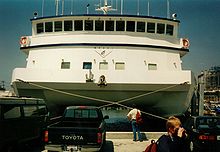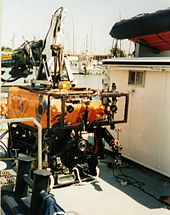93:
270:
169:
25:
140:. Monterey Bay is one of the most biologically diverse bodies of waters in the world, and the underlying submarine canyon is one of the deepest underwater canyons along the continental United States. With this 4,000-meter-deep submarine canyon only a few ship-hours from their base of operations, institute scientists enjoy an advantageous proximity to this natural, deep-sea "laboratory."
405:(ESP)—an undersea, robotic DNA laboratory. Using the ESP, researchers are able to conduct molecular biological analyses remotely, in real-time, over a sustained period, and with interactive capability. The ESP provides in situ collection and analysis of water samples, such as the analysis of the genetic material of marine microorganisms in seawater.
288:
is a 1.8 km depth-rated vehicle. It was built for the
Monterey Bay Aquarium Research Institute by International Submarine Engineering according to specifications developed by David Packard and the original core group of scientists and engineers at MBARI. The vehicle was delivered in 1988 with a
132:
At MBARI, scientists and engineers work together to develop new tools and methods for studying the ocean. Long-term funding from the David and Lucile
Packard Foundation allows the institute to take on studies that traditional granting institutions may be reluctant to sponsor. Part of David Packard's
238:
MBARI has been a pioneer in the development and scientific use of two types of underwater robots—remotely operated vehicles (ROVs) and autonomous underwater vehicles (AUVs). ROVs are robotic submersibles that are connected through a very long tether to a ship at the sea surface. They are controlled
365:
In 2008, MBARI deployed the
Monterey Accelerated Research System (MARS)—the first deep-sea cabled observatory offshore of the continental United States. MARS enables researchers to hook up a variety of scientific instruments such as earthquake monitors and low-light video cameras and leave them on
155:
MBARI's current efforts span the interdisciplinary fields of ocean science, including marine biology, geology, chemistry, and biological oceanography. MBARI also develops new oceanographic research tools and techniques, as well as technology related to ocean observatories.
300:-class AUVs currently operational at MBARI include the upper-water-column AUV, the seafloor mapping AUV, and the imaging AUV. The core vehicle elements are deep-rated (the mapping AUV is 6,000 meters rated) and have been operated as long as 20 hours.
328:
Frequent forays with remotely operated vehicles to the deep
Monterey Canyon have enabled MBARI researchers to discover new animal species on a regular basis, and to begin to understand their significance in the ecology of the deep sea.
397:
led the development of eukaryotic targeted metagenomics, which allows specific eukaryotic cells to be selected from natural samples and partial genomes from those uncultured cells then sequenced, assembled and analyzed.
159:
Much of MBARI's research focuses on the development and use of robotic vehicles and other automated methods for gathering information in the ocean. These tools provide a unique view of ocean life and physical phenomena.
315:
provides capabilities falling between existing propeller driven AUVs, which typically have endurances on the order of a day, and buoyancy-driven vehicles (gliders) that can operate for many months. In
October 2011,
393:, previously unheard of in the domain Bacteria. First developments in several areas of metagenomics have also been made at MBARI. DeLong was among the first to use metagenomics in the ocean and MBARI Scientist
239:
by pilots and researchers on board the surface ship. AUVs are robotic submersibles that are programmed at the sea surface and then released to collect data autonomously, with little or no human intervention.
129:. Christopher Scholin serves as the institute's president and chief executive officer, managing a work force of approximately 220 scientists, engineers, and operations and administrative staff.
366:
the deep seafloor for extended periods of time. Funded in 2002 by a grant from the
National Science Foundation, the MARS Observatory was developed through a collaborative effort by MBARI,
289:
standard suite of instruments and cameras. Data collection sensors, a high definition camera, and animal collection devices have been added over the course of more than 3,600 dives.
561:
296:-class AUVs are 53.3 centimetres (21.0 inches) in diameter and can be as short as 2.4 meters (7.9 feet) or as long as 6.4 meters (21 feet), depending on the mission.
502:
35:
199:
has supported ROV dives along much of the west coast of North
America, from the Gulf of California to Vancouver Island, as well as around the Hawaiian islands.
133:
charge for MBARI was to "Take risks. Ask big questions. Don't be afraid to make mistakes; if you don't make mistakes, you're not reaching far enough."
571:
385:
MBARI researchers have also made pioneering developments in the area of microbial oceanography. MBARI Postdoctoral Fellow Oded Beja and
Scientist
50:
566:
546:
292:
In addition to ROVs, MBARI has also developed untethered undersea robots called autonomous underwater vehicles (AUVs). MBARI's
143:
MBARI is not open to the general public, but it has an open house once a year. Although MBARI is a sister institution to the
541:
367:
188:
477:
126:
92:
356:
species of bone-eating worms. Bruce
Robison was also the first to observe the transparent head of the barreleye fish
72:
401:
In 2001, MBARI scientists and engineers detected the onset and development of a harmful algal bloom (HAB) using the
42:
54:
556:
402:
217:
389:
were the first to discover a gene in several species of bacteria responsible for production of the protein
346:
311:
is 30.5 cm (12.0 in) in diameter, 230 cm (7.5 ft) long, and weighs 120 kg.
371:
118:
221:
136:
MBARI's campus in Moss
Landing is located near the center of Monterey Bay, at the head of the
551:
358:
144:
86:
435:
334:
307:
AUV, also called the long-range AUV, is a new AUV designed to operate over longer ranges.
8:
98:
439:
459:
187:, a 35.6-meter (117-foot) small water-plane area twin hull (SWATH) ship deploying the
451:
246:
is a four kilometer depth-rated vehicle, named after the pioneering marine ecologist
85:
This article is about an oceanographic research center. For the public aquarium, see
463:
443:
394:
181:
137:
230:
is able to launch both ROVs and AUVs, as well as conduct multi-day expeditions.
481:
379:
203:
46:
332:
Some of the more notable species first described by MBARI researchers include
535:
517:
504:
386:
269:
122:
114:
97:
The service mark of the Monterey Bay Aquarium Research Institute depicting a
447:
455:
421:
247:
147:, the two organizations have entirely separate management and funding.
390:
340:
210:
220:(AUVs). These two boats were replaced by a single, larger boat, the
226:, which MBARI purchased in the summer of 2011. The Research Vessel
168:
478:"Discoveries of deep-sea biomass and biodiversity using an ROV"
352:
422:
G. W. Rouse; S. K. Goffredi & R. C. Vrijenhoek (2004). "
375:
209:
after 23 years of service. In 2012, MBARI also retired the
480:. Monterey Bay Aquarium Research Institute. Archived from
562:
Buildings and structures in Monterey County, California
320:
spent 24 days at sea traveling nearly 1,800 km.
195:, through a moon pool in the center of the ship. The
53:, and by adding encyclopedic content written from a
533:
216:, which served as a launch platform for MBARI's
378:'s Jet Propulsion Laboratory, L-3 MariPro, and
426:: Bone-Eating Marine Worms with Dwarf Males".
73:Learn how and when to remove this message
16:American oceanographic research institute
268:
180:MBARI's flagship research vessel is the
167:
107:Monterey Bay Aquarium Research Institute
91:
572:Research institutes established in 1987
323:
262:, which had been deployed from the R/V
534:
277:on board of the MBARI research vessel
233:
34:contains content that is written like
368:Woods Hole Oceanographic Institution
202:In December 2011, MBARI retired the
189:remotely operated underwater vehicle
18:
163:
127:David and Lucile Packard Foundation
13:
14:
583:
567:1987 establishments in California
547:Research institutes in California
258:since 2009, when it replaced ROV
125:, and is primarily funded by the
23:
254:has been deployed from the R/V
121:. MBARI was founded in 1987 by
470:
415:
403:Environmental Sample Processor
218:autonomous underwater vehicles
1:
408:
374:Applied Physics Laboratory,
7:
542:Oceanographic organizations
150:
113:) is a private, non-profit
10:
588:
84:
347:Chaetopterus pugaporcinus
372:University of Washington
350:(pigbutt worm), and the
119:Moss Landing, California
448:10.1126/science.1098650
518:36.80221°N 121.78803°W
281:
177:
102:
557:Monterey Bay Aquarium
359:Macropinna microstoma
272:
171:
145:Monterey Bay Aquarium
95:
87:Monterey Bay Aquarium
55:neutral point of view
523:36.80221; -121.78803
335:Stellamedusa ventana
324:Notable achievements
514: /
440:2004Sci...305..668R
234:Underwater vehicles
117:research center in
47:promotional content
341:Tiburonia granrojo
282:
178:
103:
49:and inappropriate
484:on 9 October 2013
434:(5684): 668–671.
83:
82:
75:
579:
529:
528:
526:
525:
524:
519:
515:
512:
511:
510:
507:
494:
493:
491:
489:
474:
468:
467:
419:
395:Alexandra Worden
172:Research vessel
164:Research vessels
78:
71:
67:
64:
58:
36:an advertisement
27:
26:
19:
587:
586:
582:
581:
580:
578:
577:
576:
532:
531:
522:
520:
516:
513:
508:
505:
503:
501:
500:
498:
497:
487:
485:
476:
475:
471:
420:
416:
411:
338:(bumpy jelly),
326:
236:
166:
153:
138:Monterey Canyon
101:
90:
79:
68:
62:
59:
40:
28:
24:
17:
12:
11:
5:
585:
575:
574:
569:
564:
559:
554:
549:
544:
496:
495:
469:
413:
412:
410:
407:
380:Alcatel-Lucent
325:
322:
235:
232:
165:
162:
152:
149:
96:
81:
80:
51:external links
31:
29:
22:
15:
9:
6:
4:
3:
2:
584:
573:
570:
568:
565:
563:
560:
558:
555:
553:
550:
548:
545:
543:
540:
539:
537:
530:
527:
483:
479:
473:
465:
461:
457:
453:
449:
445:
441:
437:
433:
429:
425:
418:
414:
406:
404:
399:
396:
392:
388:
387:Edward DeLong
383:
381:
377:
373:
369:
363:
361:
360:
355:
354:
349:
348:
343:
342:
337:
336:
330:
321:
319:
314:
310:
306:
301:
299:
295:
290:
287:
280:
276:
271:
267:
266:since 1997.
265:
264:Western Flyer
261:
257:
256:Western Flyer
253:
249:
245:
240:
231:
229:
228:Rachel Carson
225:
224:
223:Rachel Carson
219:
215:
214:
208:
207:
200:
198:
197:Western Flyer
194:
190:
186:
185:
184:Western Flyer
176:at MBARI Pier
175:
174:Western Flyer
170:
161:
157:
148:
146:
141:
139:
134:
130:
128:
124:
123:David Packard
120:
116:
115:oceanographic
112:
108:
100:
94:
88:
77:
74:
66:
56:
52:
48:
44:
38:
37:
32:This article
30:
21:
20:
552:Monterey Bay
499:
486:. Retrieved
482:the original
472:
431:
427:
423:
417:
400:
384:
364:
357:
351:
345:
339:
333:
331:
327:
317:
312:
308:
304:
302:
297:
293:
291:
285:
283:
278:
274:
263:
259:
255:
252:Doc Ricketts
251:
244:Doc Ricketts
243:
242:MBARI's ROV
241:
237:
227:
222:
212:
205:
201:
196:
193:Doc Ricketts
192:
183:
179:
173:
158:
154:
142:
135:
131:
110:
106:
104:
69:
60:
45:by removing
41:Please help
33:
521: /
509:121°47′17″W
344:(big red),
279:Point Lobos
248:Ed Ricketts
206:Point Lobos
536:Categories
506:36°48′08″N
488:4 December
409:References
99:gulper eel
63:March 2024
43:improve it
391:rhodopsin
464:34883310
456:15286372
303:MBARI's
211:RV
204:RV
182:RV
151:Research
436:Bibcode
428:Science
286:Ventana
275:Ventana
260:Tiburon
462:
454:
424:Osedax
370:, the
353:Osedax
318:Tethys
313:Tethys
309:Tethys
305:Tethys
298:Dorado
294:Dorado
250:. ROV
213:Zephyr
191:(ROV)
460:S2CID
111:MBARI
490:2012
452:PMID
376:NASA
284:ROV
273:ROV
105:The
444:doi
432:305
538::
458:.
450:.
442:.
430:.
382:.
362:.
492:.
466:.
446::
438::
109:(
89:.
76:)
70:(
65:)
61:(
57:.
39:.
Text is available under the Creative Commons Attribution-ShareAlike License. Additional terms may apply.


